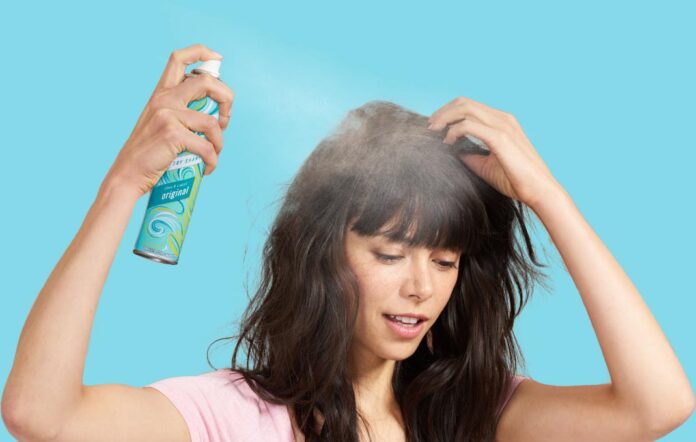Dry shampoo is a category of hair product that promises to lessen the amount of oil, grease, and debris that is present in your hair. Dry shampoo is used in place of traditional wet shampoos and conditioners, and gets its name from the fact that it is applied to dry hair. To reduce the appearance of oil and shine, dry shampoo is applied to the roots of the hair and the top of the head before being styled as usual. Dry shampoo is a popular product that can be used to refresh hair after a sweaty workout or to prolong the life of a salon finish.
How Dry Shampoo Works?
Hair follicles can be seen all over your scalp. Hair follicles, though, do more than only produce hair. And they’re responsible for making sebum, the oil that conditions the scalp and provides hair with its characteristic structure. There’s a reason sebum exists. It soothes the hair and protects the scalp at the same time. The oil and sweat from your scalp will build in your hair when you work up a sweat, spend time outside, or even just go about your daily routine.
While some oil on the head is to be expected, excessive oil can make your hair look greasy. Daily hair care routines including washing, drying, and styling can take a lot of time. What’s more, you risk damaging your hair follicles. The solution is to use dry shampoo. The active chemicals in dry shampoo often consist of alcohols or starches, and their purpose is to remove oils and sweat from the hair. Taking the oils out of your hair will give the appearance that it is cleaner. The majority of dry shampoos feature a fragrance, which gives your hair a clean scent even when you’re not washing it.
Also read about – Why Is Indique Hair Better Than Mayvenn Hair?
Organic Hair Color: Ditch the Chemicals and Go Natural
Are Hair Extensions Easy To See?
What Is The Best Way To Take Care Of Hair Extensions?
Sanotint Hair Care – A modern revolution for natural care treatment
Is Dry Shampoo Effective?
The effectiveness of dry shampoo in reducing the appearance of oily hair varies by hair type. Don’t be misled by the product’s name, which includes the word “shampoo.” The purpose of dry shampoo is not to clean your hair. Dry shampoos can mask oil and grime on the hair and scalp until you use a wet shampoo. You still need to wash your hair often if you use them. The scalp might become dry and irritated if dry shampoo is used too frequently.
Dry shampoo works best on hair that already has a tendency to produce and retain a lot of oil. If you find that even a brief exercise session or a steamy ride leaves your hair appearing oily, you may find that dry shampoo is a useful tool for providing a rapid resolution to the problem. Even though your hair turns greasy very quickly, you should still wash it frequently in order to clean your scalp and avoid clogging your pores.
If your hair has a natural tendency to be on the drier and more textured side, you should probably invest in a dry shampoo that is formulated specifically for your particular hair type. When you spray dry shampoo on your scalp, you may notice a flaky appearance if you have dark brown or black hair. This is something to keep in mind. It’s possible that buying a dry shampoo that’s formulated exclusively for darker, natural hair is the solution to this problem.
Dry instant hair colour shampoo is another option for revitalizing your look when you have curly hair, but the way you apply it might need to be adjusted. After applying dry shampoo to curly hair and letting it dry, you should not brush or comb the curls to detangle them. If you don’t, your curls can end up looking brittle and unruly rather than supple and buoyant.
How to Use Dry Shampoo
The manner in which you apply dry hair colour without ammonia shampoo can vary depending on factors such as:
- Hair Type
- Texture
- Length
- Hair’s Oiliness
To begin, ensure that your hair is completely dry and take out any pins, hair ties, or barrettes that may be in it. The following is the fundamental procedure, which can be altered as necessary:
- Keep the can of dry shampoo approximately 12 centimeters (about 6 inches) away from the top of your head.
- Apply a little bit of it by spraying it directly onto your roots. It is important not to ignore the development of hair that occurs around the nape of your neck, directly above your ears, and in the rear of your head.
- Use your fingers to work some dry shampoo through your hair. After shampooing, you may boost your hair’s volume and bounce by using a blow dryer on a cool setting while it’s still damp.
Drawbacks of Dry Shampoo
As long as you don’t overdo it, dry natural hair colour shampoo has little, if any, negative effects. You probably won’t suffer any harmful consequences from using dry shampoo either once or twice a week to refresh your blowout or style after a workout. However, there are some things that dry shampoo just can’t fix. Dry shampoo can irritate and dry up your scalp if you use it for more than two days in a row. It might also cause a rash or painful pimples on your head by blocking your pores. The use of hot tools on hair that has been treated with dry shampoo has been met with conflicting advice.
The bottom line
Dry shampoo is effective for most people since it removes grease and oil buildup in-between washes. But despite the name, it shouldn’t be used in place of actually washing your hair. Never use dry shampoo on your scalp for more than two days in a row, and keep washing with organic herbal hair colour your hair as often as you normally would.
















